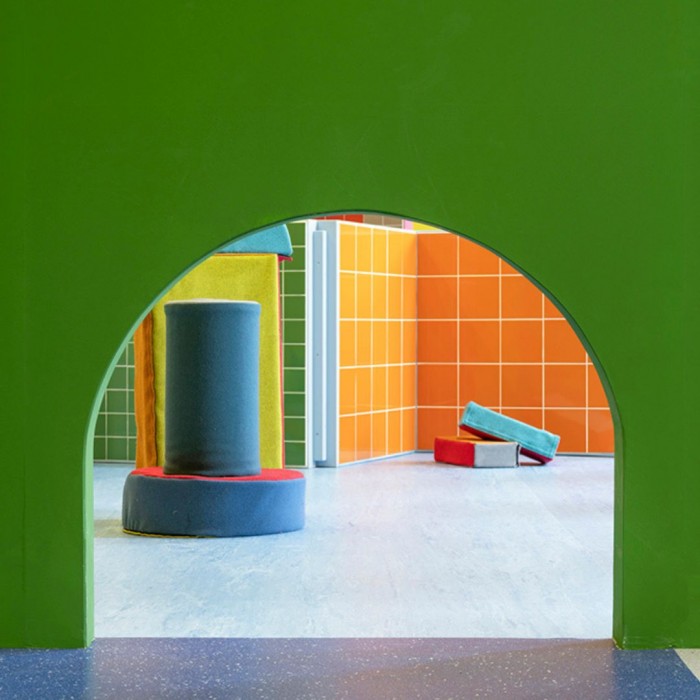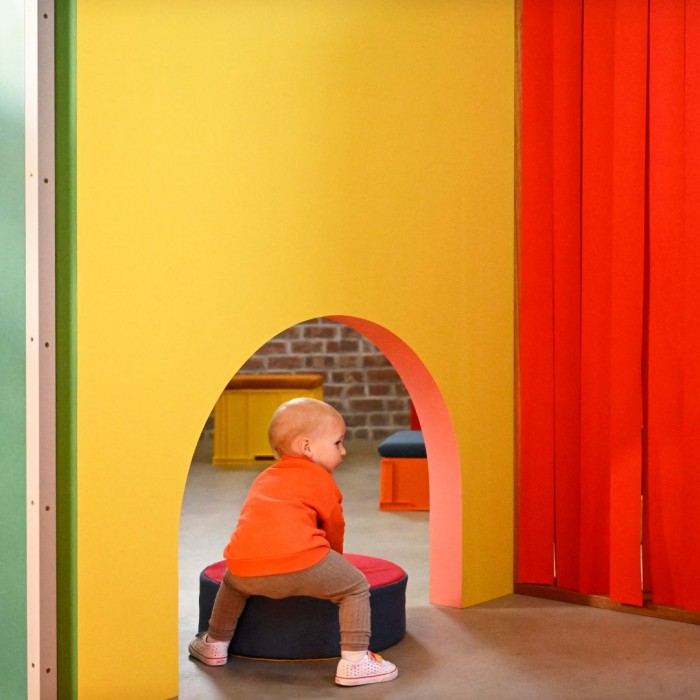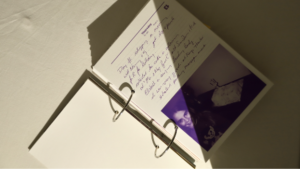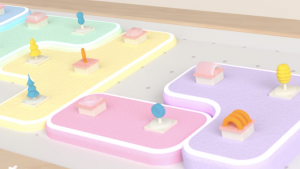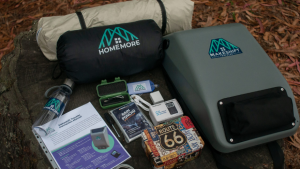Artist and designer Katie Schwab’s colourful exhibition that serves as a “touchable library” for kids (and adults), to encourage experimentation, develop creativity, experience new textiles and engage with society, is on at the City Dome at Edinburgh’s Collective until 5 March 2023.
We spoke to the exhibition’s curator, Siobhan Carroll, about the importance of fostering knowledge through play practice, the inspirations behind the exhibition, and Collective’s own “emerging creatives” project, the Satellites Programme.
Explain “The Seeing Hands” exhibition for us.
“The Seeing Hands” is a large-scale installation in Collective’s unique City Dome exhibition space. The works exhibited have been conceived, designed and produced drawing on a number of design reference points, including the unique architectural features of the City Observatory and mid-20th-century design and craft.
Katie Schwab is an artist who works with installation, textiles, furniture and moving images to explore personal and social histories of craft, design and education. Her practice is hands-on and often involves working with and alongside other people. She is interested in 20th-century domestic interiors, civic architecture and play environments.
“The Seeing Hands” is full of colour and texture, and invites visitors to touch, look through and under, add to, move and experiment freely to produce their own sculptures. The purposely adaptable sculptures have been created through collaborations with different makers and for the most part are made from remnants and recycled materials.
Collaborations include with furniture maker Simon Worthington, graphic designer Maeve Redmond, fabricators Scott Associates, and sculpture and design upholsterer Izzy Thomas.
Design references for “The Seeing Hands” include Baby-Lonia (1973), a set of educational sculptures produced by Italian avant-garde collective Studio 65; Boardrobe (1991), produced by former Memphis designers Daniel Weil and Gerard Taylor; and a 19th-century stitched Leporello workbook produced by US kindergarten teacher-trainer Ella Steigelman.
All elements of this exhibition have been specifically conceived to give children and adults tools for expression and communication, allowing them to manipulate the space and explore different forms of learning and play.
How did Katie Schwab use the book The Tactile Workshops by Bruno Munari as inspiration for “The Seeing Hands”?
In his book, Munari suggests making a haptic library for children. He believed that a catalogue of materials with different compositional and surface qualities could stimulate opportunities for engagement and education. This underpins all the work in “The Seeing Hands”.
Munari’s influence is most directly apparent in the Tactile Library, which is presented on the walls of the City Dome. It consists of an extensive selection of materials displayed on a specifically designed shelving system fabricated by furniture maker Simon Worthington. Materials include cork, ceramic, rubber, lino and carpet in a multitude of different colours and textures. The public is welcome to experiment freely with these materials: to move, regroup and stack; to play with different colour combinations, scales and textures; and to explore their limitless possibilities.
The shelf design echoes the brickwork in the City Dome. It is made from reclaimed Iroko timber, which holds the scratches and markings of its former life as school science desks. The brackets are made from ash, beech and Douglas fir offcuts from Simon’s workshop.
Collective has been featuring exhibitions with play theory and creative learning. Why do you feel it is important to make interactive installations for children as well as adults?
Learning at Collective weaves through all our programmes, aiming to co-produce knowledge between artists and the various groups we work with in our locality. Through creative learning, we create space for discussion around the ideas in our programme, in talks, play events, screenings or workshops.
Through the Covid-19 crisis and with the current economic uncertainty in the UK, this has been a time of isolation, and social and economic stress, which has exacerbated social inequalities and access to culture. Creating opportunities for learning to take place allows us to address issues around access: thinking and acting with artists, individuals and groups to navigate barriers such as ability, class, race and gender.
The benefits of developing creativity and learning through play are well documented, and Collective believe that it is crucial to nurture and encourage play for all – children and adults – in order to support future generations of potential artists, support good mental health and well-being, and promote civic responsibility through access to culture.
We have been inspired by artists who have worked with play practice, such as Nils Norman, with whom we created “Play Summit”, and Helen McCrorie who, through documenting children’s play, reflected that the process of creating art could be seen as play and that artists could be some of the only adults who still play in everyday life. Our Learning and Creative Play programme aims to create opportunities and spaces for adults, children and combinations of both to play and make together.
At Collective we believe that everyone can and should benefit from engaging in a creative process. It is important for us to create ways to empower the groups we work with and visitors to feel engagement with contemporary art and to ensure that the sector has a diverse and inclusive future, reflecting the society that it is produced in and for.
How does “The Seeing Hands” explore education and learning?
Since opening the Observatory in 2018, we have been exploring our site and exhibition programme with local families and groups using “loose parts play” theory. This is a pedagogical approach that enables children to follow their interests and undertake their own learning by using everyday objects instead of toys. Objects used for loose parts play are typically open-ended, recycled materials with interesting properties (shapes, colours and textures) to spark imagination.
All the works in Katie’s exhibition have been designed with loose parts play theory in mind, including the Tactile Library, which sits alongside a large five-screened concertinaed structure that invites different ways to interact and play. Designed by Katie and built by Scott Associates Sculpture and Design, the forms, colours and materials of this sculpture have been created with a patchwork of leftover materials, and the structure has been designed to crawl, weave and look through.
Colourful wool and foam shapes reference Baby-Lonia. The original work scaled up traditional wooden building blocks into coated polyurethane shapes that children could use to construct their own environments. These forms at Collective are made from end-of-roll melange wools and were upholstered by Izzy Thomas. Colourful upholstered Eurocrates may be used for seating and stacking, and for holding and moving materials.
Katie has also collaborated with designer Maeve Redmond to produce a tactile resource that asks the question, “How many textures can you create using these papers?”
Katie Schwab was part of Collective’s Satellites Programme in 2016. Design Indaba has a similar programme, Design Indaba Emerging Creatives, for nurturing upcoming creative talent. Why is it important for Collective to support young artists?
Collective was established in 1984 to address the lack of opportunities for artists living in Scotland to share their work in a meaningful context in Scotland’s capital city. Much has changed over the past 38 years but the need for rigorous and in-depth support of artists in Scotland while engaging in international discussions remains a unique space that Collective occupies.
The Satellites Programme is Collective’s development programme for emerging practitioners based in Scotland and is at the core of our mission and creative vision, sitting alongside and connecting to our learning and national and international artist commissioning programmes.
Satellites Programme participants are selected through an open application process to a new panel each year, made up of creative practitioners invited by Collective. Throughout the duration of the Satellites Programme, practitioners participate in a series of discussions, workshops, events, retreats and public presentations of new work, all of which seek to foster criticality through peer development and reflection.
Through the Satellites Programme, Collective aims to support creative practitioners to better understand and navigate the sector, equipping them to critically sustain and support their own practice, their peers and their community. The programme also aims to develop group dynamics and relationships in each new cohort, and to contribute to the ongoing vitality and criticality of culture in Scotland.
Read more:
Edel Rodriguez illustrates children’s book on rock icon Jimi Hendrix.
Credits: Katie Schwab, Collective Edinburgh and Harry Meadley

